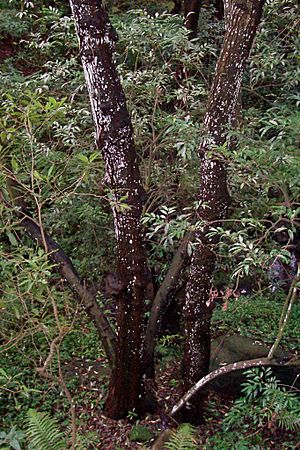Synoum facts for kids
Quick facts for kids Synoum |
|
|---|---|
 |
|
| Synoum glandulosum - Chatswood West, Australia | |
| Scientific classification | |
| Genus: |
Synoum
|
| Species: |
glandulosum
|
Synoum is a type of evergreen tree that belongs to the plant family Meliaceae. It is the only species in its group, which is why it's called a monotypic genus. This tree grows naturally only in Australia. You can find it along the eastern coast, from sub-tropical to tropical areas. It often grows at the edges of rainforests in Queensland and New South Wales.
A French scientist named Adrien-Henri de Jussieu first described this group of plants in 1830.
The only recognized species is Synoum glandulosum, which is commonly known as scentless rosewood. It looks a bit like another tree called Toona. However, Synoum glandulosum leaves usually have 5 to 9 smaller leaves (called leaflets), while Toona has more, typically 8 to 20 leaflets.
What Synoum Glandulosum Looks Like
This tree produces fruit that ripens between December and January. The fruit is reddish and shaped like a three-lobed capsule. Inside, it holds two or three seeds. Each seed is covered by a red, fleshy part called an aril. If you plant fresh seeds, they usually sprout easily and quickly.
Uses of Synoum Timber
The wood from Synoum trees is quite useful. People use it in local building projects for things like house frames, floors, and decorative parts (mouldings). It's also used to make furniture, fixtures for shops and offices, and wall panels.
Beyond that, Synoum timber can be carved and turned into different shapes. It's also used to make strong plywood, planks for scaffolding, and materials like wood wool. This wood can even be processed into paper products, particleboard, and medium density fibreboard (MDF).
Gallery
See also
 In Spanish: Synoum glandulosum para niños
In Spanish: Synoum glandulosum para niños







